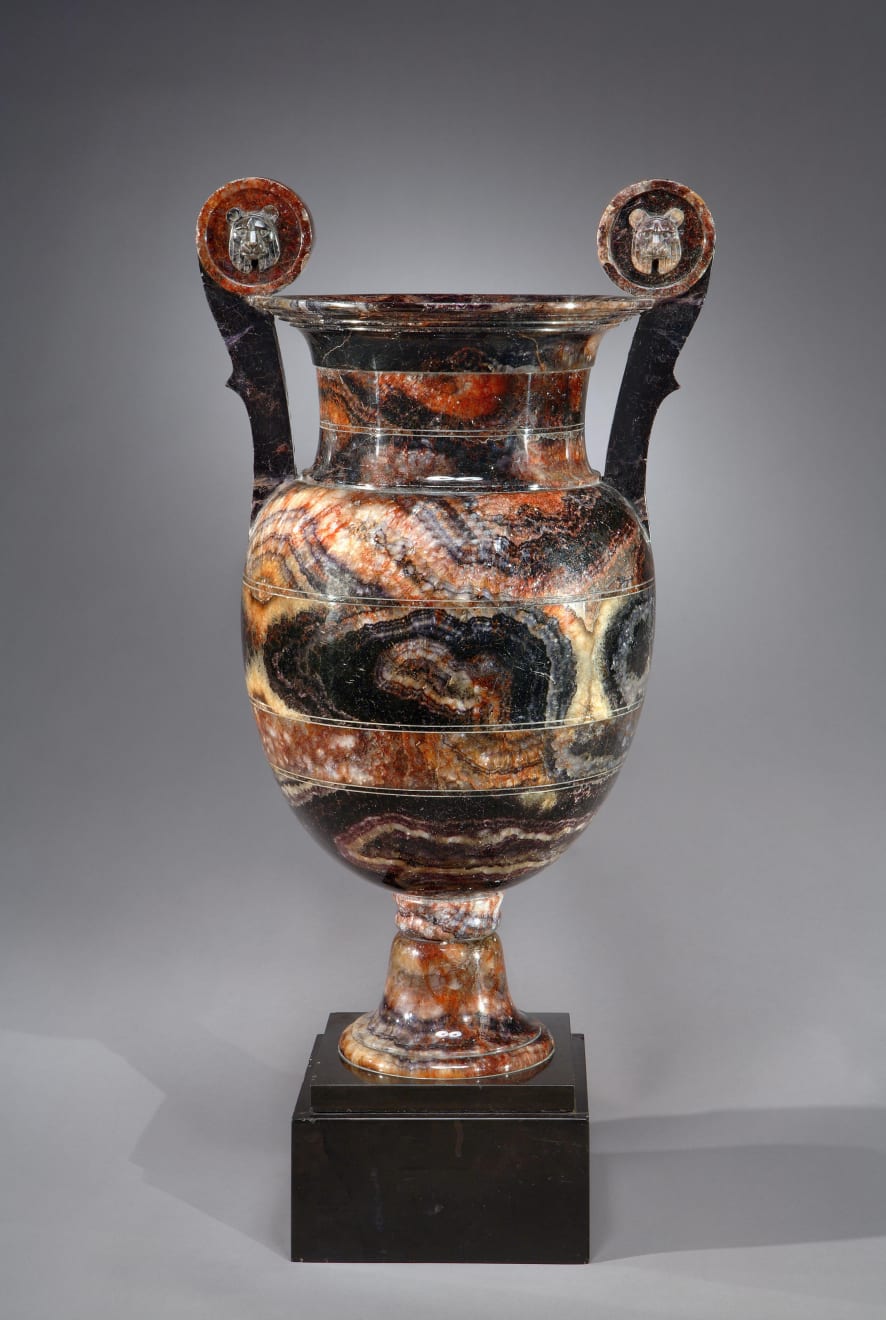Regency Blue John Krater-Form Vase
ENGLAND, circa 1815
75.6 x 36.8 cm
Provenance
(Almost certainly) Collection of James Shore (who made it). (Almost certainly) On his death passed to the Collection of John Mawe (1766-1829). (Almost certainly) On his death passed to the Collection of William Adam, on whose death it was sold at auction in 1849. Whereabouts unknown until 1950s when it appeared in a Private Collection USA. Acquired Private Collection, Mexico during 1970s.Exhibitions
Rienzi, Museum of Fine Arts, Houston, 2009–2010
Literature
William Adam, Gem of the Peak, 4th edition, 1848, includes an engraving of what appears to be this vase.The body and stem of the vase made from sections of “Organ Room Vein” and “Bull Beef Vein” of Blue John, the handles arms constructed of “New Cavern Vein” with the roundels and leopards’ heads of Bull Beef Vein; the whole on a base of polished Derbyshire limestone.
The profile of this vase is derived from an ancient Greek pottery krater, a large vessel intended for wine. Thomas Hope designed several vases of this form in bronze and gilt metal, including one appropriately ornamented with ‘Bacchanalian masks, vine wreaths, and other emblems of Bacchus’. It is interesting to note that the masks to the handles are possibly derived from a design published in 1798 for ‘Antique Vases in dark oriental Marbles from the Collection in the Museum of the Vatican’ by C. H. Tatham in Etchings representing the best examples of Ancient Ornamental Architecture; drawn from the originals in Rome, and other parts of Italy, during the years 1794, 1795, and 1796.
The extraordinary scale of this blue john vase is rivalled only by the later vase by Vallance on display at the Natural History Museum. No other vase of this size is known. The very finest vein of blue john has been chosen in order to maximize the fascination for the complexity of the markings in this stone. The blue john would then have been carefully fired which creates the reddish colour in the vein. This was an extremely delicate process – if fired for too long the blue john would lose its colour altogether.
The extraordinary scale of this blue john vase is rivalled only by the later vase by Vallance on display at the Natural History Museum. No other vase of this size is known. The very finest vein of blue john has been chosen in order to maximize the fascination for the complexity of the markings in this stone. The blue john would then have been carefully fired which creates the reddish colour in the vein. This was an extremely delicate process; if fired for too long the blue john would lose its colour altogether.
This impressive blue john vase is closely related to another vase of similar form, now in the collection of the Duke of Devonshire at Chatsworth House, Derbyshire (T. Ford, Derbyshire Blue John, Ashbourne: Landmark Publishing, 2000, p. 86), which is thought to have been made in 1815 by James Shore of Matlock Bath, Derbyshire. Little is known of Shore other than his claim that his vase, which measured 24 inches high including the plinth, was the largest ever made. After his death the vase passed to John Mawe, another worker in blue john, who had shops in Matlock, Castleton, Cheltenham, Scarborough and London, and then to William Adam who sold it in 1849. It is not known conclusively whether Shore’s famous vase is the one at Chatsworth as previously thought, or in fact the vase offered here.

